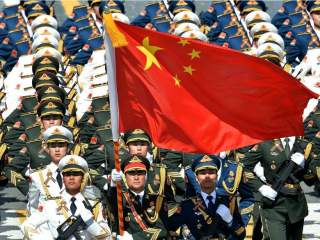Five Ways War with China Could Be Started… or Avoided
How a changing naval balance in the Pacific could turn deadly.
Beyond the “blinding” and “deafening” implications of space warfare, both sides are also increasing their focus on electronic warfare (EW), both to confuse enemy missiles and to jam adversary communications. The Pentagon has established an Electronic Warfare Executive Committee to protect the U.S. EW position and coordinate EW activity across the services. According to the U.S. Air Force’s intelligence center, electronic warfare is a key component of PLA combat doctrine and training and China now indigenously produces advanced electronic warfare components for its various platforms.
Which side will prevail in a future “blinding” competition? As the “home team” and a continental power, China would have the easier task. It will have more territory and bases from which to operate, compared to the U.S. expeditionary forces, which would operate from either a handful of island bases and naval task forces. If both sides disrupted each others’ satellite networks, China would have an easier time reconstituting airborne surveillance and communications relay networks to support a campaign in its home region. On the other hand, the U.S. alliance system in the region would be a major asset and would be especially useful for supporting and reconstituting reconnaissance and communications. As with the other concepts discussed, uncertainty over the outcome of both sides’ blinding programs is likely to grow.
5. Will offensive cyber operations affect tactical outcomes?
China’s cyber intelligence gathering operations are well known. These operations are thought to include cyber break-ins to Lockheed Martin’s F-35 design files, intrusions into U.S. health care and credit card databases, and allegedly scooping up twenty-two million personnel files from the U.S. Office of Personnel Management. What is less clear is the PLA’s capability to employ cyber weapons to disrupt, distort and damage the U.S. military’s sensor and command networks, especially during critical periods of military operations. China’s success at cyber intelligence operations should presumably indicate similar high competence at offensive cyber disruption, even if that capability has yet to be observed.
For its part, the United States is also thought to possess high-level offensive cyber capabilities. In spite of budgets pressures in recent years, the Pentagon has consistently expanded its cyber capacities. It built a national cyber test range where is now regularly conducts force-on-force cyber combat simulations and training.
Even so, U.S. defense officials almost never discuss their offensive cyber capabilities nor have such capabilities been openly demonstrated. What effect offensive cyber operations would have on adversary tactical military operations remains a mystery, at least to outsiders. The Stuxnet cyber attack against Iran’s nuclear program, thought to be a joint U.S.-Israeli effort, created only temporary damage and little change to the program’s long-term trajectory. Without clearer demonstrations of offensive cyber effects, adversaries are likely to harbor wide disagreements about cyber’s implications for military operations.
Should disagreements about these (and numerous other) technical and tactical questions grow, military planners and policymakers on both sides will perceive and misperceive opportunities for military advantage. History abounds with such disagreements, which led both sides to conclude that their war plan would work. It took a war to find out who was right:
Would the Iraqi army in Kuwait in 1991 inflict frightening casualties on counter-attacking coalition forces the same way it recently had against Iran? Saddam thought yes, U.S. commanders thought no.
Could the Japanese army in 1942 fight down the Malay peninsula jungle and capture Singapore from the north? General Yamashita said yes, General Percival said no.
Could the British navy in 1982 mount a successful transoceanic amphibious assault to recapture the Falkland Islands? Argentine commanders said no, British commanders said yes.
Today, Chinese and U.S. military planners and policymakers likely agree on the correlation of forces in the western Pacific. But on current trends, that agreement will change to disagreement, greatly increasing the danger of conflict. When that happens, the temptation for the PLA to forcefully oppose a future U.S. freedom of navigation patrol or other such encounter will rise.
U.S. officials can stop the slide to dangerous disagreement by either reversing the trends discussed with these five concepts, or by reinforcing other, possibly new concepts that will remove any doubts about the outcome from escalation and conflict.
Robert Haddick is a Visiting Senior Fellow at the Mitchell Institute for Aerospace Studies and the author of Fire on the Water: China, America, and the Future of the Pacific.
Image: Wikimedia Commons/Kremlin.ru

